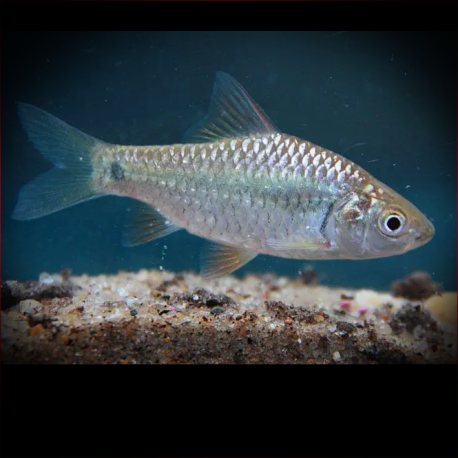More info
Datasheet
| Minimum Tank Size | 270 litres / 71.33 US gallons |
| Maximum Size | 13.0cm / 5.12inches |
| Temperature | 18°C / 64.40°F - 26°C / 78.80°F |
| Hardness | 2.02dgH / 36ppm - 15.02dgH / 268ppm |
| pH | 5.5-8.0 |
General Description
The Swamp Barb, scientifically known as Puntius chola, is a species of small to mid-sized cyprinid characterized by possessing a single pair of barbels and a distinct color pattern with dark blotches. Belonging to the Cyprinidae family, it is classified under the Cypriniformes order. This species, sometimes called 'chola' or 'green' barb, typically reaches a maximum size of 13.0cm. It is an omnivore, feeding on worms, insects, small invertebrates, and plant material in its natural habitat.
Aquarium Setup
For housing Swamp Barbs, a tank size of at least 270 liters is recommended. The aquarium should be set up with a natural-style arrangement, including a substrate of sand or gravel, large rocks, pebbles, driftwood, and branches. Lighting can be subdued, and plant species such as Microsorum, Taxiphyllum, or Anubias can be added. Water conditions should ideally maintain a pH level of 5.5-8.0, hardness of 36-268ppm, and a temperature range of 18-26°C (see table).
Behaviour
This species displays schooling behavior by nature, making it ideal to keep in groups of 6 or more for a cohesive hierarchy and a more natural appearance. When housed with peaceful fish of appropriate size and disposition, such as cyprinids and loaches, aggressive behavior is usually minimal. Research is crucial when selecting tank mates to ensure compatibility within the community.
Feeding and Diet
Swamp Barbs are omnivorous and can consume a variety of foods such as worms, insects, plant material, and organic detritus. In captivity, they should be offered regular meals of small live and frozen foods like bloodworms, Daphnia, and Artemia. High-quality dried flakes and granules with plant or algal content can also be included in their diet.
Reproduction & Dimorphism
Information regarding the reproduction of Puntius chola is yet to be recorded. Adult females tend to be slightly larger, heavier-bodied, and less colorful compared to males. Male Swamp Barbs exhibit orangish anal and pelvic fins, while females lack these colorations. During mating periods, some populations of Swamp Barbs develop a red lateral stripe from the opercle to the caudal peduncle.
Habitat and Distribution
Swamp Barbs are distributed across various regions including Pakistan, India, Nepal, Bhutan, Bangladesh, Sri Lanka, Myanmar, and western Thailand. They are commonly found in minor streams, rivers, irrigation canals, and oxbow lakes, showing a preference for still waters with muddy or silty substrates. During the wet season, they may enter inundated zones like beels and haors. One example of their habitat includes the Bhadra River in Karnataka, India, where they coexist with diverse fish species in water conditions of moderate temperature, neutral pH, and low hardness.

